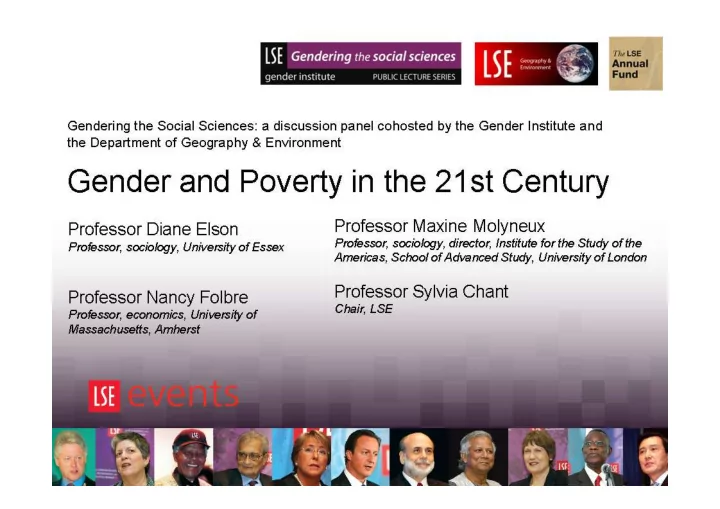

Gender, Poverty, and Inequality Nancy Folbre Professor of Economics University of Massachusetts Amherst
A Feminist Critique of Political Economy Neoclassical economic theory is too market-centric and Marxian economic theory is too capitalism-centric. Neither pays sufficient attention to the social organization of care. Collective conflict over the distribution of the costs of caring for dependents cross-cuts conflict over the distribution of “surplus.”
Why Caregivers are Economically Vulnerable 1. Care for human dependents is costly. 2. Asymmetric investment in individual offspring by caregivers puts them at a disadvantage 3. Caregivers can be “held hostage” by their emotional attachment. 4. Children are “non-excludable” in consumption (public goods) 5. Contractual arrangements for control of children or even partial “payback” are difficult to enforce.
����������������������� Capitalism emerges in a patriarchal context. Undermines some aspect of patriarchy and weakens other. Women gained “permission” to participate in capitalism gradually, in the face of ideological and political resistance from men (see Greed, Lust, and Gender ).
Women Gain “Self-Ownership” Wage employment is based on individual market work, not family work Women engage in collective Both wage employment and fertility political action. decline empower women.
Problem: “self ownership” is not sufficient to guarantee gender inequality if women continue to specialize in producing things (e.g. the next generation) that they cannot own. The position of women improves but position of mothers deteriorates-- pauperization of motherhood or “motherization of poverty.”
Care Penalties Motherhood is economically risky. • Mothers are paid significantly less • than other women, all else equal. Jobs that require “nurturance” are • paid significantly less than other jobs, all else equal. Occupational segregation in “caring” • jobs explains a large part of the difference in men’s and women’s pay.
The Price of Care is Rising In the family—a higher opportunity cost of women’s time • In the market—reduction of supply to caring occupations • In the polity—greater demand for services such as child care, elder care, home • health care Responses to Increased Prices • Distributional conflict • Cultural backlash • Outsourcing and immigration • Institutional efforts to control costs and improve efficiency. • Automation and use of information technology
Capitalism is Depicted in Masculine Terms…
…the Welfare State in Feminine Terms
The “Welfare State” DOES Fulfill a “Feminine” Role Much entitlement and discretionary social spending is devoted to care of dependents. There is nation-based, race/ethnicity based, gender-based, age-based and class-based conflict over who should pay the costs of care. Globalization is increasing class conflict, because national boundaries are becoming less relevant. Why grow and educate your own workers when you can free ride on the efforts of other families/nations?
Family Policy: A Neoliberal Dilemma Capitalist institutions need families but would prefer not to pay for them. International competition intensifies pressure to offload or externalize costs to non-market sectors.
Parallels with Global Warming • Difficulty of coordinating regulation of a public good (the future!) • Unsustainable utilization of unpriced assets—forests, fish, families, communities. • Negative spillovers (or externalities) in the form of crime, poor health, inadequate development of human capabilities. • High deficit/debt partly a symptom of distributional conflict.
Research Agenda Our measures of poverty and inequality are incomplete. We need better measures of the intra-family resource flows (both time and money). We also need better measures of lifecycle contributions to and benefits from the state based on gender and age.
Also, a different theoretical currency…
Recommend
More recommend